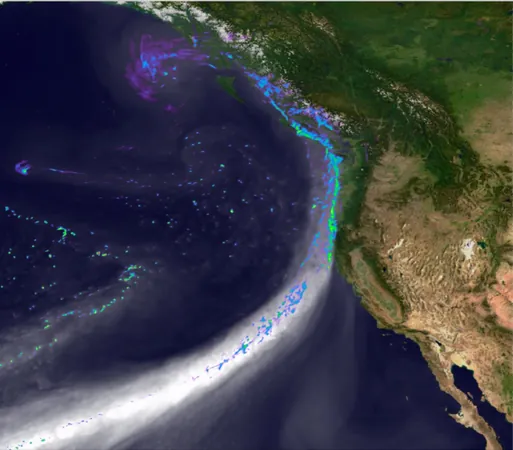
Unlocking the Secrets of Flooding: Why Wet Soils Wreak Havoc During Atmospheric Rivers
2025-06-12
Author: Nur
The Dual Nature of Atmospheric Rivers
Atmospheric rivers are notorious for causing severe flooding along the West Coast of the U.S., but they also play a crucial role in replenishing moisture in the region. Surprisingly, the sheer size of these storms doesn't solely dictate flood risk—ground conditions significantly influence the situation.
Groundbreaking Research Unleashes New Insights
A groundbreaking study, published in the Journal of Hydrometeorology on June 4, analyzed over 43,000 atmospheric river storms spanning 122 watersheds from 1980 to 2023. The researchers uncovered an eye-opening truth: wet soils act as a primary catalyst for flooding. In fact, flood peaks soared by an astounding 2 to 4.5 times when soils were already saturated.
What Makes Some Storms Deadly While Others Deliver Relief?
This new research elucidates why certain atmospheric river storms trigger catastrophic floods, while others do not—even if their intensity is comparable. Weaker storms can unleash devastating floods if they strike a saturated ground, whereas stronger storms might merely quench the thirst of a parched landscape.
A Deeper Dive Into Soil Conditions
"The key takeaway is that flooding depends not only on storm size but also on what's happening with the soil," stated Mariana Webb, the lead author and Ph.D. candidate at DRI and the University of Nevada, Reno. She highlighted that floods are not merely a linear function of soil moisture; they reach a critical threshold where an increase in wetness causes disproportionately large flood flows.
Diverse Landscapes, Diversified Flood Risks
The study also explored how environmental conditions influence flooding across different regions. In arid areas like California and southwestern Oregon, storms striking already saturated soils are more prone to flooding due to their shallow, clay-rich soils and limited water retention. Conversely, lush regions like Washington benefit from deeper soils and snowpack, making them less vulnerable to sudden influxes of water.
Enhancing Prediction Accuracy with Soil Data
Webb aims to identify watersheds where soil moisture data can significantly refine flood risk assessments. Particularly in dry climates where soil moisture fluctuates due to evaporation and unpredictable rainfall, understanding soil saturation could revolutionize flood prediction.
The Path Forward: Enhanced Monitoring and Interdisciplinary Collaboration
Currently, soil moisture measurements lag behind other data, like rainfall, largely due to sparse observation stations. Yet, increased monitoring in high-risk watersheds could dramatically improve early warning systems and flood management as atmospheric rivers become more prevalent.
Bridging the Gap Between Two Fields
Webb's research highlights the importance of integrating atmospheric science with hydrology for more effective flood risk assessments. Collaborating with ecohydrologist Christine Albano, she aims to fuse these disciplines to unlock better predictions that could save lives and mitigate disaster.
In Conclusion: A New Era of Flood Risk Awareness
With advanced weather forecasting allowing us to anticipate atmospheric rivers days in advance, understanding how soil conditions interact with these storms could be pivotal in protecting communities along the West Coast. The findings of this study mark a significant leap forward in flood risk evaluation and preparedness.





 Brasil (PT)
Brasil (PT)
 Canada (EN)
Canada (EN)
 Chile (ES)
Chile (ES)
 Česko (CS)
Česko (CS)
 대한민국 (KO)
대한민국 (KO)
 España (ES)
España (ES)
 France (FR)
France (FR)
 Hong Kong (EN)
Hong Kong (EN)
 Italia (IT)
Italia (IT)
 日本 (JA)
日本 (JA)
 Magyarország (HU)
Magyarország (HU)
 Norge (NO)
Norge (NO)
 Polska (PL)
Polska (PL)
 Schweiz (DE)
Schweiz (DE)
 Singapore (EN)
Singapore (EN)
 Sverige (SV)
Sverige (SV)
 Suomi (FI)
Suomi (FI)
 Türkiye (TR)
Türkiye (TR)
 الإمارات العربية المتحدة (AR)
الإمارات العربية المتحدة (AR)